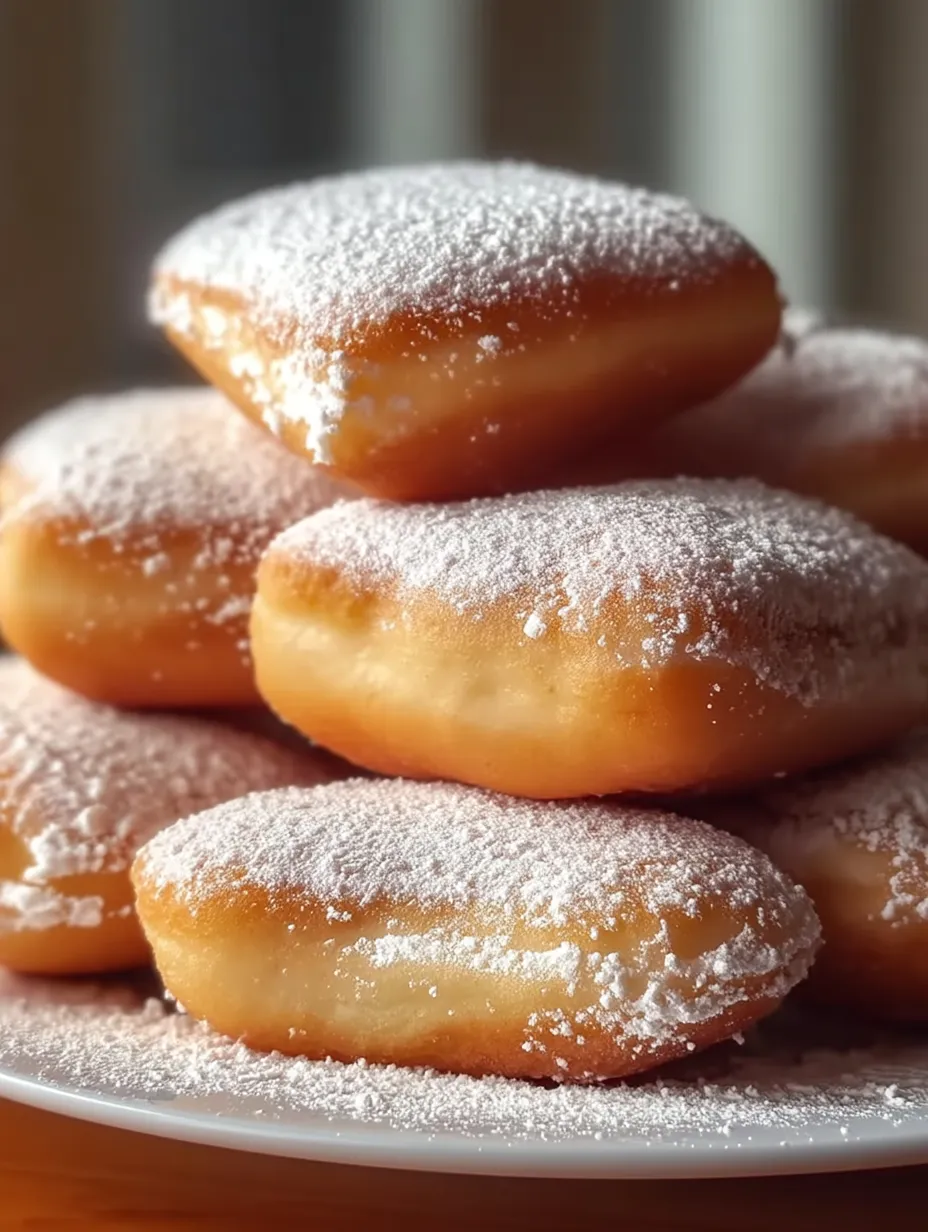 Save Pin
Save Pin
These fluffy vanilla French beignets turn basic cupboard items into airy, sugar-dusted treats. You'll get that genuine New Orleans taste at home thanks to the magic of vanilla and yeast working together.
I first tried these beignets while visiting New Orleans and I've tweaked the recipe many times since then. These days my kids beg for them as weekend morning treats, particularly when we've got company over.
What You'll Need
- All purpose flour: Gives the right framework while keeping everything soft
- Granulated sugar: Brings mild sweetness that doesn't take over
- Active dry yeast: Makes those lovely bubbles for an airy result
- Warm milk: Wakes up the yeast and adds a nice richness
- Eggs: Add moisture and richness that set these beignets apart
- Vanilla extract: Adds cozy flavor depth throughout
- Unsalted butter: Creates richness and helps make everything tender
- Salt: Boosts all the tastes and cuts through sweetness
- Vegetable oil: For frying - pick one without much taste that won't burn easily
- Powdered sugar: For topping - don't hold back for that classic look
Cooking Process
- Wake Up Your Yeast:
- Mix warm milk at about 110°F with your dry yeast in a little bowl. Getting the temperature right matters a lot - too warm kills yeast, too cool won't wake it up. Wait 5-10 minutes until you see foam on top showing your yeast is working.
- Mix Your Base:
- Stir flour, sugar, and salt together in a big bowl to spread everything evenly. Make a hole in the middle like a crater and pour in your foamy yeast mix, eggs, melted butter, and vanilla. Start stirring slowly, then faster until you get a sticky, rough-looking dough.
- Work The Dough:
- Move your dough to a lightly floured counter and knead for 5-7 minutes. This builds strength that gives beignets their nice chew. The dough will change from rough and sticky to smooth and bouncy. It should slowly spring back when you poke it.
- Let It Grow:
- Put your worked dough in a greased bowl covered with a kitchen towel. Find a cozy spot without drafts and let it grow for 1-1.5 hours. This wait is worth it for better flavor and texture. The dough should grow twice as big.
- Cut Your Squares:
- Gently push down on the puffy dough to release air. Roll it out on a floured surface about half inch thick. Cut into 2x2 inch squares using a sharp knife or pizza cutter. Make clean cuts for even cooking.
- Get Ready To Fry:
- Heat your vegetable oil in a heavy pot to exactly 350°F. Use a thermometer because getting this right matters a lot. Oil that's too cool makes greasy beignets, too hot and they burn outside while staying raw inside.
- Fry Until Golden:
- Cook just 3-4 beignets at once so the oil stays hot. Each square needs room to float and puff up. Fry about 1-2 minutes per side until they turn a nice golden brown. They should puff up dramatically in the hot oil.
- Add The Sugar Coating:
- Put fried beignets on paper towels to drain off extra oil, then cover them heavily with powdered sugar while they're still warm. The heat helps the sugar stick better. Go really heavy with the sugar for that authentic look.
 Save Pin
Save Pin
The vanilla in these beignets really brings out the yeasty goodness in a way that makes them hard to resist. A chef from New Orleans once told me that good vanilla makes all the difference. When my grandma first bit into one, she closed her eyes and said it took her straight back to her childhood trips to Louisiana.
Plan Ahead Ideas
You can mix up your dough the evening before and let it rise slowly in the fridge overnight. This cold process actually makes the flavor even better and saves you time in the morning. Just take the dough out about 30 minutes before you want to roll it so it warms up a bit and isn't too stiff.
 Save Pin
Save Pin
Great Companions
Most folks enjoy these beignets with café au lait, which is just strong coffee mixed with hot milk. The slight bitterness of coffee works really well with the sweet pastries. For something different, try them with hot chocolate or even a sweet wine for a fancy evening snack. Adding some tart fruit sauce on the side helps balance out the richness.
History Notes
Beignets came to New Orleans with French settlers back in the 1700s and became a staple in Louisiana Creole cooking. The name "beignet" comes from an old Celtic word "bigne" meaning "to raise." They got famous at Café du Monde in the French Quarter, which has been selling them around the clock since 1862. This home version keeps the real feel while being doable for anyone.
Common Problems Solved
If your beignets aren't puffing up right, your oil temperature is probably jumping around too much. Keep a thermometer in there and adjust your burner as needed.
Common Questions
- → How do I ensure the dough is properly risen?
Put your dough in a cozy spot, throw a kitchen towel over it, and wait until it gets twice as big. This usually takes about an hour to an hour and a half.
- → What oil is best for frying beignets?
Vegetable oil works great because it doesn't burn easily and won't add weird flavors. Make sure your oil hits 350°F for the best results.
- → How do I achieve the right texture for beignets?
Work the dough until it feels smooth in your hands, and don't cook them too long. Good beignets should puff up nicely and have a golden color.
- → Can I prepare the dough in advance?
You can totally make the dough ahead and keep it in the fridge after it rises once. Just let it warm up on the counter before you start frying.
- → Why is the yeast mixture not frothy?
Your milk temperature might be off. It needs to be warm (around 110°F) to wake up the yeast and get it working.
